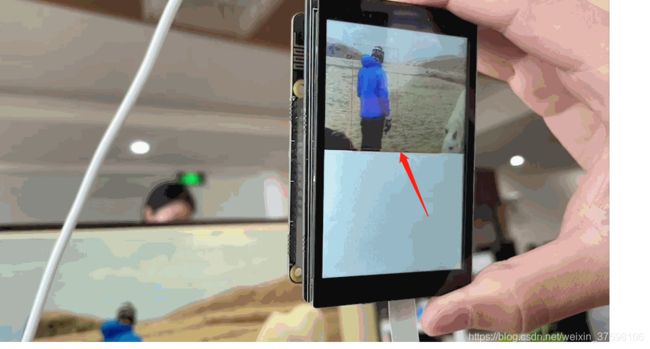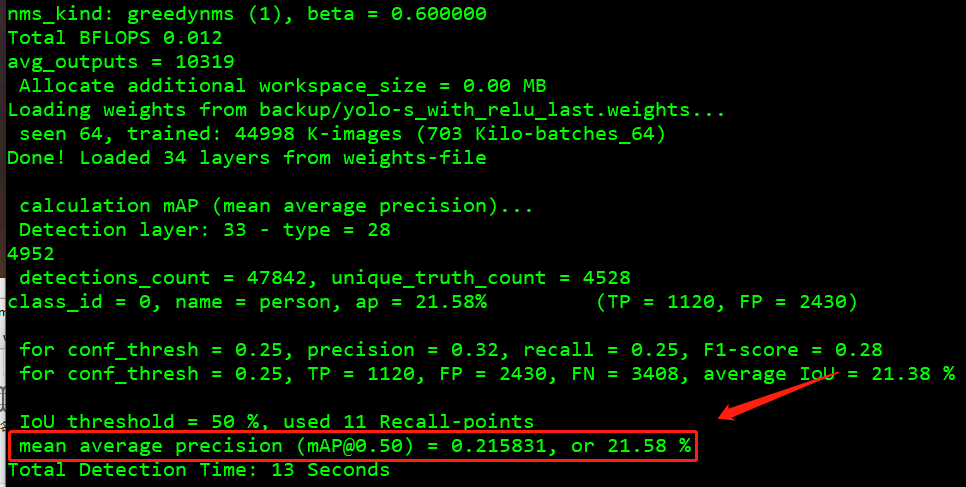ART-PI 嵌入式人形检测 附源码(RT-AK Demo)
Person detection
文章目录
- 1 模型
-
- 1.1 参考项目
- 1.2 模型文件
- 1.3 自己训练模型
- 2 RT-AK 使用
- 3 应用代码
- 4. 参考链接
让 AI 在你的板子上尽情舞蹈~
本次实验的是识别摄像头中的人,就一个人,而不是多个。
从多类别检测模型改编而来,只保留 person 这个类别,根据各位看官的能力完全可以改成识别多类
本次项目的篇幅将会较长,请各位看官耐心看完
源码地址:Project4-Person_detection_RT-AK
整体分为三部分:
- 模型
- RT-AK 使用
- 板子上的应用层代码实现
硬件平台 ART-Pi, 50M FLOPS。
我的模型(删减后的模型)最终部署在板子上是推理时间是56ms,不包括数据处理时间。
- pc 端推理一张图片:
$ pip install -r requirements.txt
$ python inference_yolo-s.py
- 以下是在 ART-PI 上的模型推理实现:
我的模型数据:map 21.58%
| Model | MACC | Inference | Size |
|---|---|---|---|
| yolo-s.tflite | 6.5 M | 50ms | 144k |
1 模型
1.1 参考项目
参考项目:
Yolo-Fastest https://github.com/dog-qiuqiu/Yolo-Fastest
keras-YOLOv3-model-set https://github.com/david8862/keras-YOLOv3-model-set
原因:目前了解的全网最轻量级的目标检测网络,没有之一
现在不是了,出现了一个 ppyolo,百度产
| Network | Model Size | mAP(VOC 2017) | FLOPS |
|---|---|---|---|
| Tiny YOLOv2 | 60.5MB | 57.1% | 6.97BFlops |
| Tiny YOLOv3 | 33.4MB | 58.4% | 5.52BFlops |
| YOLO Nano | 4.0MB | 69.1% | 4.51Bflops |
| MobileNetv2-SSD-Lite | 13.8MB | 68.6% | &Bflops |
| MobileNetV2-YOLOv3 | 11.52MB | 70.20% | 2.02Bflos |
| Pelee-SSD | 21.68MB | 70.09% | 2.40Bflos |
| Yolo Fastest | 1.3MB | 61.02% | 0.23Bflops |
| Yolo Fastest-XL | 3.5MB | 69.43% | 0.70Bflops |
| MobileNetv2-Yolo-Lite | 8.0MB | 73.26% | 1.80Bflops |
当然,Yolo Fastest 最小的模型也有 0.23 Bflops,想要在 ART-Pi 上顺利的跑起来,肉眼可见的丝滑程度,我是在做梦。。。
这时候有两个办法:
- 换一块板子,换一块算力更大的板子。
- 将模型改的小一点,能够在 ART-PI 上丝滑的跑起来。
这里我选择的是后者。
我改动的很简单,去掉特征金字塔输出,只保留一个输出,保证对大物体检测友好即可。同时删减网络结构。原来是109层,我是20+层网络结构。
纠正一个思想误区,由于一些很神奇的存在,网络并不是越深,FLOPS 就会越大,比如 DSCNN。
第二个参考项目的意义是在于:将模型转变为 tflite 可食用模型
1.2 模型文件
-
我改动的模型配置文件:
./model/yolo-s_with_lrelu.cfg原模型配置文件:
./model/VOC为了防止在后期模型转换的过程中遇到不支持的算子:
leakyrelu,我这里提供了一份relu的模型训练配置文件 -
预先训练好的模型:
./model/yolo-s.h5507 k,量化的tflite模型文件:./model/yolo-s.tflite144 k
1.3 自己训练模型
请参考:dog-qiuqiu/Yolo-Fastest 项目
我自己也写过一份 快速上手 yolo-fastest 教程:
https://blog.csdn.net/weixin_37598106/article/details/112544854?spm=1001.2014.3001.5501
但是由于 up 主更新的比较快,可能有一些版本落后,仅供参考。
-
需要配置
darknet训练环境,然后根据需求修改下cfg文件即可 -
准备数据集:
VOC 2007 + VOC 2012wget https://pjreddie.com/media/files/VOCtrainval_11-May-2012.tar wget https://pjreddie.com/media/files/VOCtrainval_06-Nov-2007.tar wget https://pjreddie.com/media/files/VOCtest_06-Nov-2007.tar tar xf VOCtrainval_11-May-2012.tar tar xf VOCtrainval_06-Nov-2007.tar tar xf VOCtest_06-Nov-2007.tar wget https://pjreddie.com/media/files/voc_label.py # 修改文件,将里面的类别只保留 person 类别 python voc_label.py cat 2007_train.txt 2007_val.txt 2012_*.txt > train.txt
修改 ./model/voc_person.data 中的 train 和 valid 路径,注意,如果你不是训练 person 单类别,请一并修改 voc_person.names 文件
-
训练
$ ./darknet detector train <data_path> <cfg_path> # 举例, -dont_show 是不显示图片, -gpus 是指定 gpu 训练 $ ./darknet detector train voc_person.data yolo-s.cfg -dont_show -gpus 0, 1 -
测试
perons.jpg位于./imgs# test 1 image ./darknet detector test voc_person.data yolo-s.cfg yolo-s_last.weights person.jpg -thresh 0.5 -dont_show # mAP ./darknet detector map voc_person.data yolo-s.cfg yolo-s_last.weights -points 11模型转换成
keras,最后转成tflite对应的代码仓库:
Lebhoryi/keras-YOLOv3-model-set
转自 david8862/keras-YOLOv3-model-set,我做了一些修改,请按照我的来,否则出错请自负# yolo-fastest to keras python tools/model_converter/convert.py cfg/yolo-s.cfg weights/yolo-s_last.weights weights/yolo-s.h5 -f -c # keras to tflite python tools/model_converter/custom_tflite_convert.py --keras_model_file ./weights/yolo-s.h5 --output_file ./weights/yolo-s.tflite # keras to tflite; quantize python tools/model_converter/post_train_quant_convert.py --keras_model_file ./weights/yolo-s.h5 --annotation_file /home/lebhoryi/Data/VOC/2007_test.txt --model_input_shape 160x160 --sample_num 30 --output_file ./weights/yolo-s.tflite -c
2 RT-AK 使用
具体使用请查阅 RT-Thread/RT-AK https://github.com/RT-Thread/RT-AK 相关文档
准备:
- ART-PI bsp
- 模型
- RT-AK
使用:
$ git clone https://github.com/RT-Thread/RT-AK
$ cd RT-AK/RT-AK/rt_ai_tools
# 只需要改动 --model、--project、--ext_tools 三个参数的路径即可
$ python aitools.py --model=./yolo-s.h5 --model_name=person_yolo --project=D:\RT-ThreadStudio\workspace\art-pi --platform stm32 --ext_tools="D:\Program Files (x86)\stm32ai-windows-5.2.0\windows" --clear
3 应用代码
我的输入是 160x160x1,为了减小模型参数大小,
先在 pc 端实现应用层的代码
- 图片预处理:尺度缩放+灰度转化+归一化
- yolo 解码
- nms 处理
代码都在 inference_yolo-s.py 中。
手边没有 usb 摄像头,也就没有写视频的推理代码,只有图片的推理代码。
功能实现:
-
图片预处理
python里头就很简单,调用opencv库,几行代码搞定img_raw = cv2.imread(str(img_path)) img = cv2.cvtColor(img_raw, cv2.COLOR_BGR2GRAY) img = cv2.resize(img, (160, 160), interpolation=cv2.INTER_LINEAR) img = img / 255.0 img = np.asarray(img).astype('float32') -
yolo 解码
inference_yolo-s.py中的yolo_decode函数模型推理的是检测目标的
xywh的偏移量,目的是将模型输出结果转换成真实世界的xywh这部分呢,我也写了一篇文章,感兴趣的可以看一下:
掌握 yolo - 解码核心思想 https://blog.csdn.net/weixin_37598106/article/details/113058426?spm=1001.2014.3001.5501
-
nms
inference_yolo-s.py中的non_max_suppress函数,这个函数针对的是单类别的
c 代码的实现比较痛苦,,痛苦面具 x3
- 灰度转换
- 尺度缩放
- yolo 解码
- nms (可能五一节后实现)
-
灰度转换
RGB转灰度,通常会使用下面的一个心理学公式:(Matlab和OpenCV中使用的也是该公式)
Gray = 0.2989*R + 0.5870*G + 0.1140*B # 优化 Gray = (2989*R + 5870*G + 1140*B)/ 10000 # 移位 Gray = (4898*R + 9618*G + 1868*B)>> 14 # 8位精度 Gray = (76*R + 150*G + 30*B)>> 8// c 代码实现 void rgb2gray(unsigned char *src,unsigned char *dst, int width,int height) { int r, g, b; for (int i=0; i<width*height; ++i) { r = *src++; // load red g = *src++; // load green b = *src++; // load blue // build weighted average: *dst++ = (r * 76 + g * 150 + b * 30) >> 8; } }# python 代码实现 # val_c_gray_scaling.py def img2gray(img_path): # 读取第一张图像 img = cv2.imread(img_path) # 获取图像尺寸 h, w = img.shape[0:2] # 自定义空白单通道图像,用于存放灰度图 gray = np.zeros((h, w), dtype=img.dtype) # 对原图像进行遍历,然后分别对B\G\R按比例灰度化 for i in range(h): for j in range(w): gray[i, j] = 0.11 * img[i, j, 0] + 0.59 * img[i, j, 1] + 0.3 * img[i, j, 2] # Y=0.3R+0.59G+0.11B show_img(gray) return gray -
尺度缩放
此处用的是双线性插值
int is_in_array(short x, short y, short height, short width) { if (x >= 0 && x < width && y >= 0 && y < height) return 1; else return 0; } void bilinera_interpolation(rt_uint8_t* in_array, short height, short width, rt_uint8_t* out_array, short out_height, short out_width) { double h_times = (double)out_height / (double)height, w_times = (double)out_width / (double)width; short x1, y1, x2, y2, f11, f12, f21, f22; double x, y; for (int i = 0; i < out_height; i++){ for (int j = 0; j < out_width; j++){ x = j / w_times; y = i / h_times; x1 = (short)(x - 1); x2 = (short)(x + 1); y1 = (short)(y + 1); y2 = (short)(y - 1); f11 = is_in_array(x1, y1, height, width) ? in_array[y1*width+x1] : 0; f12 = is_in_array(x1, y2, height, width) ? in_array[y2*width+x1] : 0; f21 = is_in_array(x2, y1, height, width) ? in_array[y1*width+x2] : 0; f22 = is_in_array(x2, y2, height, width) ? in_array[y2*width+x2] : 0; out_array[i*out_width+j] = (rt_uint8_t)(((f11 * (x2 - x) * (y2 - y)) + (f21 * (x - x1) * (y2 - y)) + (f12 * (x2 - x) * (y - y1)) + (f22 * (x - x1) * (y - y1))) / ((x2 - x1) * (y2 - y1))); } } }python代码实现:val_c_gray_scaling.py中的bilinera_interpolation函数 -
yolo 解码
// c 代码实现 // applications/yolo.c int yolo_decode(float *out_data) { int j=0,k=0,l=0; for(int i=0; i<5*5*5; i++) { float x_tmp = 1 / (1 + exp(-out_data[i*6+0])); float y_tmp = 1 / (1 + exp(-out_data[i*6+1])); float box_x = (x_tmp + k) / 5; float box_y = (y_tmp + l) / 5; float box_w = (exp(out_data[i*6+2])*anchor[j][0])/ input_dims[0]; float box_h = (exp(out_data[i*6+3])*anchor[j][1])/ input_dims[1]; float objectness = 1 / (1 + exp(-out_data[i*6+4])); float class_scores = 1 / (1 + exp(-out_data[i*6+5])); // printf("%d %d %d %f %f, %f %f, %f %f\n", j,k,l, box_x, box_y, box_w, box_h, objectness, class_scores); out_data[i*6+0] = box_x; out_data[i*6+1] = box_y; out_data[i*6+2] = box_w; out_data[i*6+3] = box_h; out_data[i*6+4] = objectness; out_data[i*6+5] = class_scores; if(j++>=4) { j = 0; if(k++>=4) { k = 0; if(l++>=4) { l = 0; } } } } return 0; }python 代码实现:
inference_yolo-s.py中的yolo_decode函数 -
nms
没有
nms的目标检测工程就等于没有灵魂,,,等后期来实现
编译报错以及解决
第二种解决方式:
4. 参考链接
-
C++ RGB转灰度图像 https://blog.csdn.net/martinkeith/article/details/104185635
-
GBeetle/c_image_processing https://github.com/GBeetle/c_image_processing/blob/4ceabf4959f455f5b7d1ee419aac25eccf231b3b/scaling/scaling.c#L155
-
https://github.com/dog-qiuqiu/Yolo-Fastest
-
https://github.com/david8862/keras-YOLOv3-model-set




